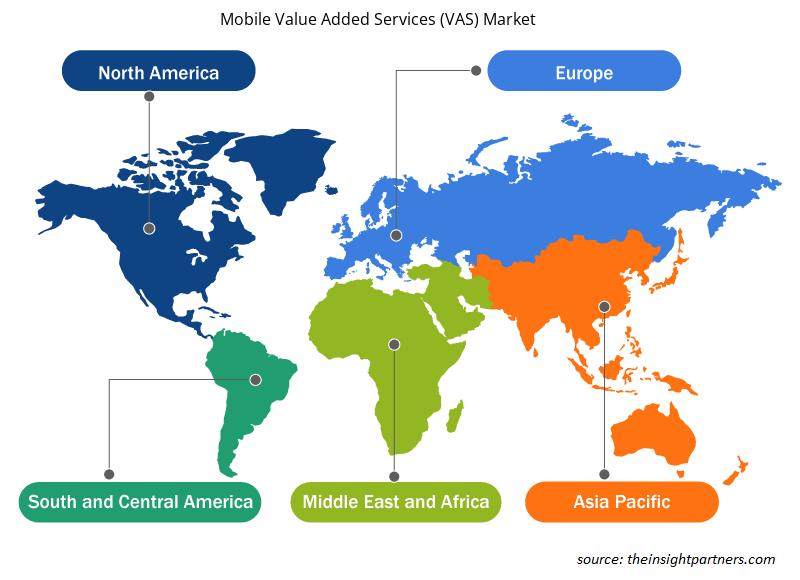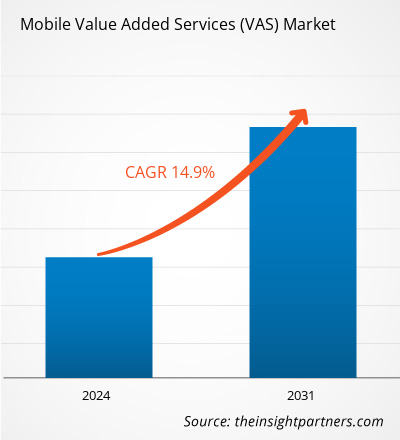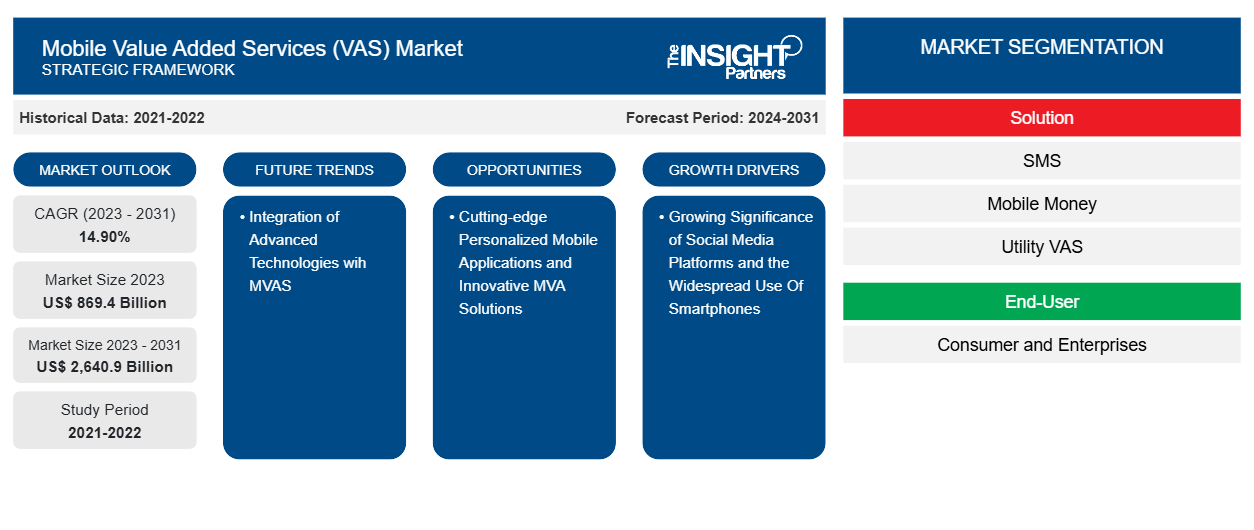移动增值服务 (VAS) 市场规模预计将从 2023 年的 8694 亿美元增至 2031 年的 26409 亿美元。预计 2023-2031 年期间该市场的复合年增长率将达到 14.90%。社交媒体平台的日益增长和智能手机的广泛使用可能仍是移动增值服务 (VAS) 市场的主要趋势。
移动增值服务 (VAS) 市场分析
以合理的价格轻松访问混合和更新的内容正在推动 OTT 的增长,OTT 是移动增值服务的一部分。电信公司通过与娱乐行业的在线观看平台(如 Netflix)合作提供增值服务。此类合作在支付、内容交付、互动营销和客户服务方面为增值服务做出了贡献。
移动增值服务 (VAS) 市场概况
移动增值服务 (MVAS) 包括语音通信服务以及移动服务提供商提供的其他附加服务。这些服务使移动用户能够利用智能手机和平板电脑实现各种非语音用途,包括发送短信服务 (SMS)、多媒体消息服务 (MMS)、移动电子邮件和即时消息、移动货币、基于位置的服务、移动广告和移动信息娱乐。MVAS 作为高级功能或基本服务的补充进行营销,用于提高各种服务的管理和运营效率。它们通过增加最终用户功能并提供用于商业用途的改进分析和数据,为服务提供商和客户带来益处。
定制此报告以满足您的需求
您可以免费定制任何报告,包括本报告的部分内容、国家级分析、Excel 数据包,以及为初创企业和大学提供优惠和折扣
-
获取此报告的关键市场趋势。这个免费样品将包括数据分析,从市场趋势到估计和预测。
移动增值服务 (VAS) 市场驱动因素和机遇
社交媒体平台的重要性日益提高以及智能手机的广泛使用
各种各样的供应商和互联网服务提供商之间的激烈竞争正在大力实施数字解决方案、先进的应用程序和众多增值服务。智能手机被用于访问各种互联网应用程序,如浏览在线网站、共享电子邮件和在社交媒体平台上互动。电信提供商提供广泛的移动增值服务,包括语音、短信和数据服务以及其他附加服务,以改善整体用户体验。廉价智能手机的日益普及是推动低收入人群采用设备的关键因素,这加剧了全球对移动增值服务的需求。因此,社交媒体平台日益增长的重要性和智能手机的广泛使用是推动移动增值服务 (VAS) 市场增长的关键因素。SMS, and data services, among other additional services, to improve the overall user experience. The growing availability of budget-friendly smartphones is a key factor boosting device adoption among the populations with low income, which contributes to the demand for mobile value added services worldwide. Thus, the growing significance of social media platforms and the widespread use of smartphones are key factors fueling the mobile value added service (VAS) market growth.
尖端个性化移动应用和创新MVA解决方案MVA Solutions
全球各地的电信运营商和服务提供商推出了各种新颖、富有创意的个性化移动应用和移动增值服务 (VAS),以满足不断变化的消费者需求。移动增值服务用户和智能手机用户数量的增长等因素塑造了充满活力的市场环境。此外,企业和消费者对定制增值服务的需求也推动了移动增值服务 (VAS) 市场的扩张。这一趋势凸显了该行业致力于通过尖端的移动解决方案和服务来满足消费者和企业不断变化的需求。VAS) are being introduced by telecom operators and service providers worldwide to address evolving consumer demands. The dynamic market environment is shaped by factors such as the growing population of mobile VAS subscribers and smartphone users. Moreover, the desire for tailored value added services from both businesses and consumers contributes to the expansion of the mobile value added services (VAS) market. This trend highlights the industry's commitment to meeting the evolving needs of consumers and businesses through cutting-edge mobile solutions and services.
移动增值服务 (VAS) 市场报告细分分析VAS) Market Report Segmentation Analysis
有助于得出移动增值服务(VAS)市场分析的关键部分是解决方案和最终用户。VAS) market analysis are solution and end user.
- 根据解决方案,市场细分为短信、移动货币、公用事业增值服务、移动信息娱乐、社交网络、基于位置的服务等。短信部门在 2023 年占据了相当大的市场份额。SMS, mobile money, utility VAS, mobile infotainment, social networking, location-based services, and others. The SMS segment held a substantial market share in 2023.
- 根据最终用户,市场分为消费者和企业。2023 年,消费者市场占有相当大的份额。
移动增值服务 (VAS) 市场份额分析(按地区)
移动增值服务(VAS)市场报告的地理范围主要分为五个地区:北美、亚太、欧洲、中东和非洲、南美和中美。
亚太地区拥有大量手机用户,这些设备主要用于娱乐目的,例如观看新闻和电影、手机银行等。亚太地区移动增值服务 (VAS) 市场的增长归因于使用各种移动增值服务的企业和垂直行业数量的增加,以及该地区零售、电子商务以及 IT 和电信行业的蓬勃发展。
移动增值服务 (VAS) 市场区域洞察
Insight Partners 的分析师已详尽解释了预测期内影响移动增值服务 (VAS) 市场的区域趋势和因素。本节还讨论了北美、欧洲、亚太地区、中东和非洲以及南美和中美洲的移动增值服务 (VAS) 市场细分和地理位置。

- 获取移动增值服务 (VAS) 市场的区域特定数据
移动增值服务 (VAS) 市场报告范围
| 报告属性 | 细节 |
|---|---|
| 2023 年的市场规模 | 8694 亿美元 |
| 2031 年市场规模 | 26409亿美元 |
| 全球复合年增长率(2023 - 2031) | 14.90% |
| 史料 | 2021-2022 |
| 预测期 | 2024-2031 |
| 涵盖的领域 |
按解决方案
|
| 覆盖地区和国家 |
北美
|
| 市场领导者和主要公司简介 |
|
移动增值服务 (VAS) 市场参与者密度:了解其对业务动态的影响
移动增值服务 (VAS) 市场正在快速增长,这得益于终端用户需求的不断增长,而这些需求又源于消费者偏好的不断变化、技术进步以及对产品优势的认识不断提高等因素。随着需求的增加,企业正在扩大其产品范围,进行创新以满足消费者的需求,并利用新兴趋势,从而进一步推动市场增长。
市场参与者密度是指在特定市场或行业内运营的企业或公司的分布情况。它表明在给定市场空间中,相对于其规模或总市场价值,有多少竞争对手(市场参与者)存在。
在移动增值服务 (VAS) 市场运营的主要公司有:
- 所得税收抵免
- Airtel(Robi Axiata 有限公司)
- 移动
- 喀麦隆
- Numeko Bili?im Teknoloji Sanayi Ticaret A.?。
- 阿曼电信公司
免责声明:上面列出的公司没有按照任何特定顺序排列。

- 获取移动增值服务 (VAS) 市场顶级关键参与者概览
移动增值服务 (VAS) 市场新闻和最新发展
移动增值服务 (VAS) 市场通过收集一手和二手研究后的定性和定量数据进行评估,其中包括重要的公司出版物、协会数据和数据库。以下列出了移动增值服务 (VAS) 市场的一些发展情况:
- Monty Mobile 是一家快速发展的全球电信公司,提供创新技术和通信解决方案,该公司宣布将人工智能和机器学习整合到其增值服务 (VAS) 中。这项名为 OmniVAS 的整合将使移动运营商的收入在短时间内实现两位数增长。通过利用数据挖掘,这种最先进的人工智能解决方案可以自动分析消费者行为,优化追加销售和交叉销售,这直接有助于提高客户满意度,从而通过提高销售额、通过机器学习和令人大开眼界的见解提高对客户行为的理解来增加运营商的收入,使他们能够做出明智的决策和预测。(来源:Monty Mobile,新闻稿,2023 年)
- 聊天商务和商业消息传递领导者 Clickatell 已为南非最大的综合通信公司 Telkom 推出了 Chat 2 Pay 功能。Telkom 的数百万客户现在可以在该国最大的聊天渠道 WhatsApp 上付款。(来源:Clickatell,公司网站,2023 年)
移动增值服务 (VAS) 市场报告覆盖范围和交付成果
“移动增值服务 (VAS) 市场规模和预测(2021-2031)”报告对市场进行了详细分析,涵盖以下领域:
- 范围内涵盖的所有主要细分市场的全球、区域和国家层面的移动增值服务 (VAS) 市场规模和预测
- 移动增值服务 (VAS) 市场趋势以及市场动态,如驱动因素、限制因素和关键机遇
- 详细的 PEST/波特五力分析和 SWOT 分析
- 移动增值服务 (VAS) 市场分析涵盖主要市场趋势、全球和区域框架、主要参与者、法规和最新市场发展
- 行业格局和竞争分析,涵盖市场集中度、热图分析、知名参与者以及移动增值服务 (VAS) 市场的最新发展
- 详细的公司简介
- 历史分析(2 年)、基准年、预测(7 年)及复合年增长率
- PEST和SWOT分析
- 市场规模、价值/数量 - 全球、区域、国家
- 行业和竞争格局
- Excel 数据集
近期报告
客户评价
购买理由
- 明智的决策
- 了解市场动态
- 竞争分析
- 客户洞察
- 市场预测
- 风险规避
- 战略规划
- 投资论证
- 识别新兴市场
- 优化营销策略
- 提升运营效率
- 顺应监管趋势























 获取免费样品 - 移动增值服务(VAS)市场
获取免费样品 - 移动增值服务(VAS)市场